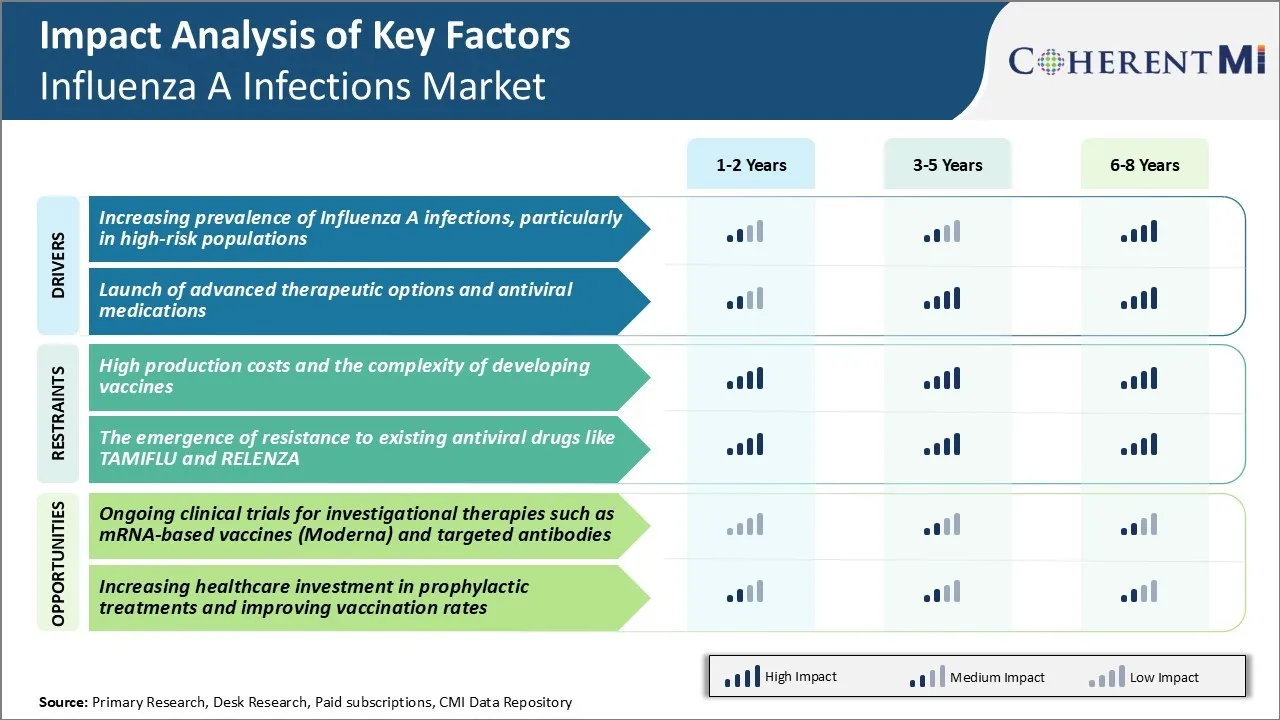Influenza A Infections Market Trends
Market Driver - Increasing Prevalence of Influenza A Infections, Particularly in High-risk Populations
As per CDC statistics, the hospitalization rate due to influenza is nearly six times higher in adults aged 65 years and above in comparison to young healthy adults. Furthermore, individuals with chronic pulmonary disorders or cardiac illnesses have over twenty times greater likelihood of developing severe pneumonia if infected with these respiratory pathogens. Likewise, the underdeveloped immune system in infants and toddlers places them at an elevated risk of influenza-related complications.
During the most recent flu seasons, health authorities have reported above-average influenza activity levels along with rising hospitalization and mortality figures associated with these viral illnesses. The evolving epidemiological patterns indicate that the threat posed by these contagious respiratory viruses is no longer seasonal but rather perpetual.
Moreover, the emergence and worldwide spread of antiviral resistance in certain influenza virus strains adds an additional layer of complexity to disease management. Considering these interrelated factors, it is reasonable to expect that the target patient groups will continue experiencing disproportionately higher influenza disease burden in the coming years unless effective control measures are implemented.
Market Driver - Launch of Advanced Therapeutic Options and Antiviral Medications
In addition to optimizing existing antiviral classes, developers have also explored wholly novel antiviral targets such as endonuclease and cap-dependent endonuclease inhibitors that may offer broader spectrum activity against multiple influenza strains. Another active area of research involves host-targeting agents focusing on processes like virus attachment, fusion and immune modulation using novel monoclonal antibody platforms or host directed small molecules. Advanced formulations involving nanoparticle-based drug delivery carriers are further improving dosage convenience and therapeutic compliance for antiviral medications especially in pediatric populations.
On the vaccine front, technologies for rapid development and production of updated seasonal vaccine strains are accelerating the timeliness of protective strategies. Investigational programs on universal influenza vaccines capable of inducing durable immunity against diverse strains also hold promise to transform the current preventive landscape in the future. Collectively, the sizable R&D investments and ensuing approvals of these expanded treatment avenues are expected to bring about notable enhancements in clinical outcomes and quality of care for patients impacted by influenza A virus infections worldwide.

Market Challenge - High production costs and the complexity of developing vaccines
One of the major challenges faced by players in the influenza A infections market is the high production costs associated with developing effective vaccines. Vaccine manufacturing is an intricate and expensive process that involves growing virus strains in fertile hen eggs or cell cultures. This is followed by inactivation, purification and formulation of the antigen. Ensuring consistency and scalability further adds to the costs.
Additionally, the influenza virus is constantly mutating, necessitating annual updates to the vaccine composition. Developing vaccines targeting multiple strains simultaneously increases R&D investments substantially. Manufacturers must also conduct extensive clinical trials to establish safety, immunogenicity and efficacy. All these factors contribute to the high resource requirements for vaccine innovation.
Many companies, especially smaller players, find it difficult to justify the investments without guaranteed demand and profitability. This poses a major barrier to expanding vaccine access and achieving higher vaccination rates globally.
Market Opportunities - Ongoing Clinical Trials for Investigational Therapies
The influenza A infections market sees promising opportunities from recent advancements in vaccine production technologies. Several companies are investing in novel platforms that can accelerate development and lower costs. For instance, Moderna is evaluating an mRNA-based universal influenza vaccine in clinical trials. mRNA vaccines have the potential to provide multi-strain protection with a more streamlined manufacturing process compared to egg- or cell-based methods.
Other therapies under investigation include recombinant vaccines and therapeutic antibodies targeting specific viral proteins. Targeted antibodies may enable treatment of high-risk patients even after symptoms emerge. Several players are also exploring the feasibility of pan-influenza vaccines conferring long-term immunity against all influenza strains.
If successful, such investigational therapies could capture a large market share and shift treatment paradigms. They offer opportunities for continued patent protection and high profit margins. Ongoing clinical research in this domain is expected to drive significant growth within the influenza A infections market over the forecast period.